Applied Corporate Strategy Analysis for Sainsbury's Company
VerifiedAdded on 2023/01/12
|19
|5135
|23
Report
AI Summary
This report provides a comprehensive analysis of Sainsbury's corporate strategy, examining its external environment through PESTLE and Porter's Five Forces models, and its internal resources and capabilities via VRIO analysis. The report begins with an introduction to corporate strategy, followed by an in-depth look at the political, economic, social, technological, environmental, and legal factors influencing Sainsbury's operations. It then assesses the competitive landscape, including the threat of new entrants, bargaining power of suppliers and buyers, threat of substitutes, and rivalry among competitors. The internal analysis utilizes the VRIO framework to evaluate Sainsbury's resources and capabilities, determining their value, rarity, imitability, and organization. The report concludes with a strategy evaluation, summarizing key findings and their implications for Sainsbury's strategic direction. The report aims to identify opportunities and threats, assess the company's competitive advantages, and provide insights into its strategic decision-making process within the UK supermarket industry.
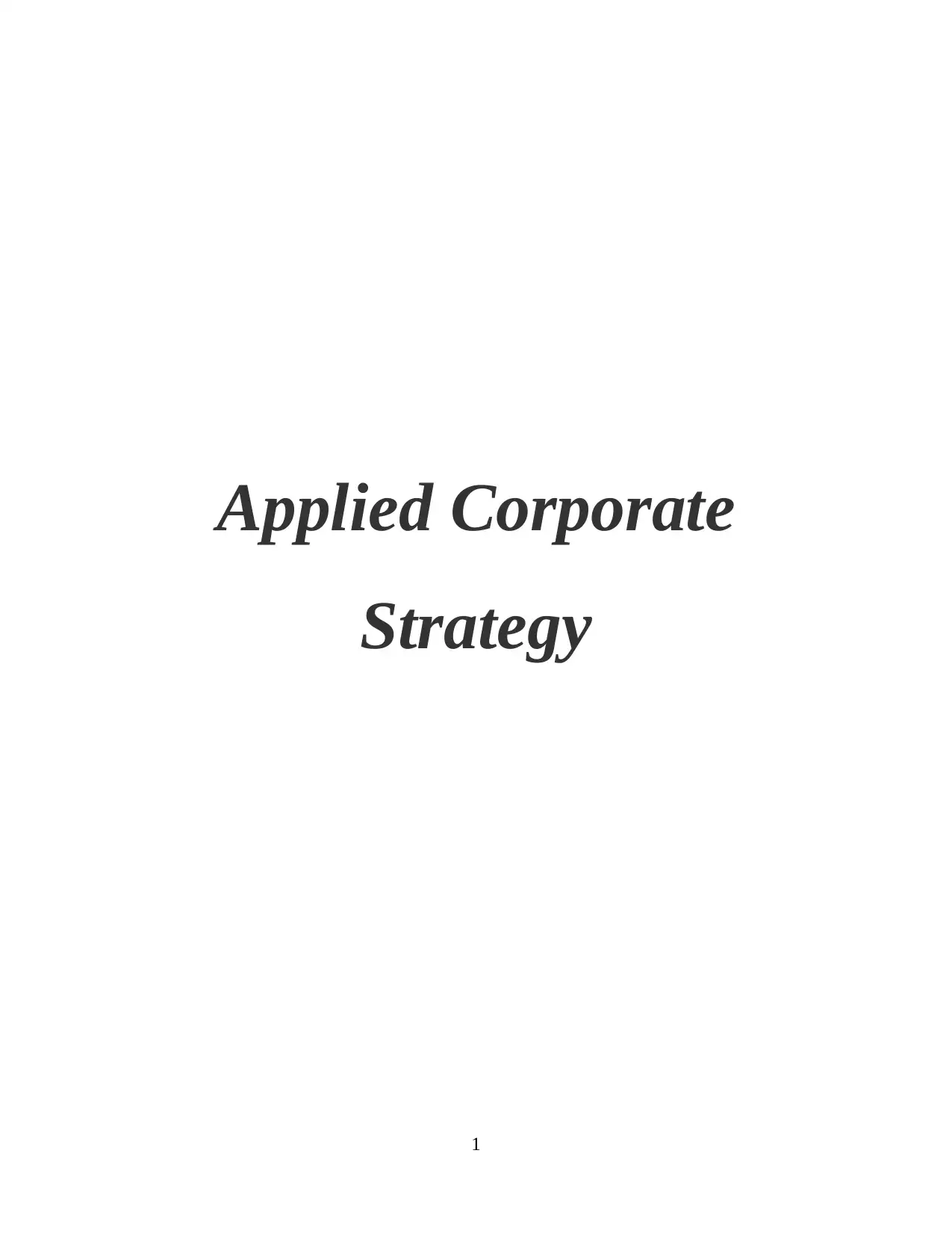
Applied Corporate
Strategy
1
Strategy
1
Paraphrase This Document
Need a fresh take? Get an instant paraphrase of this document with our AI Paraphraser
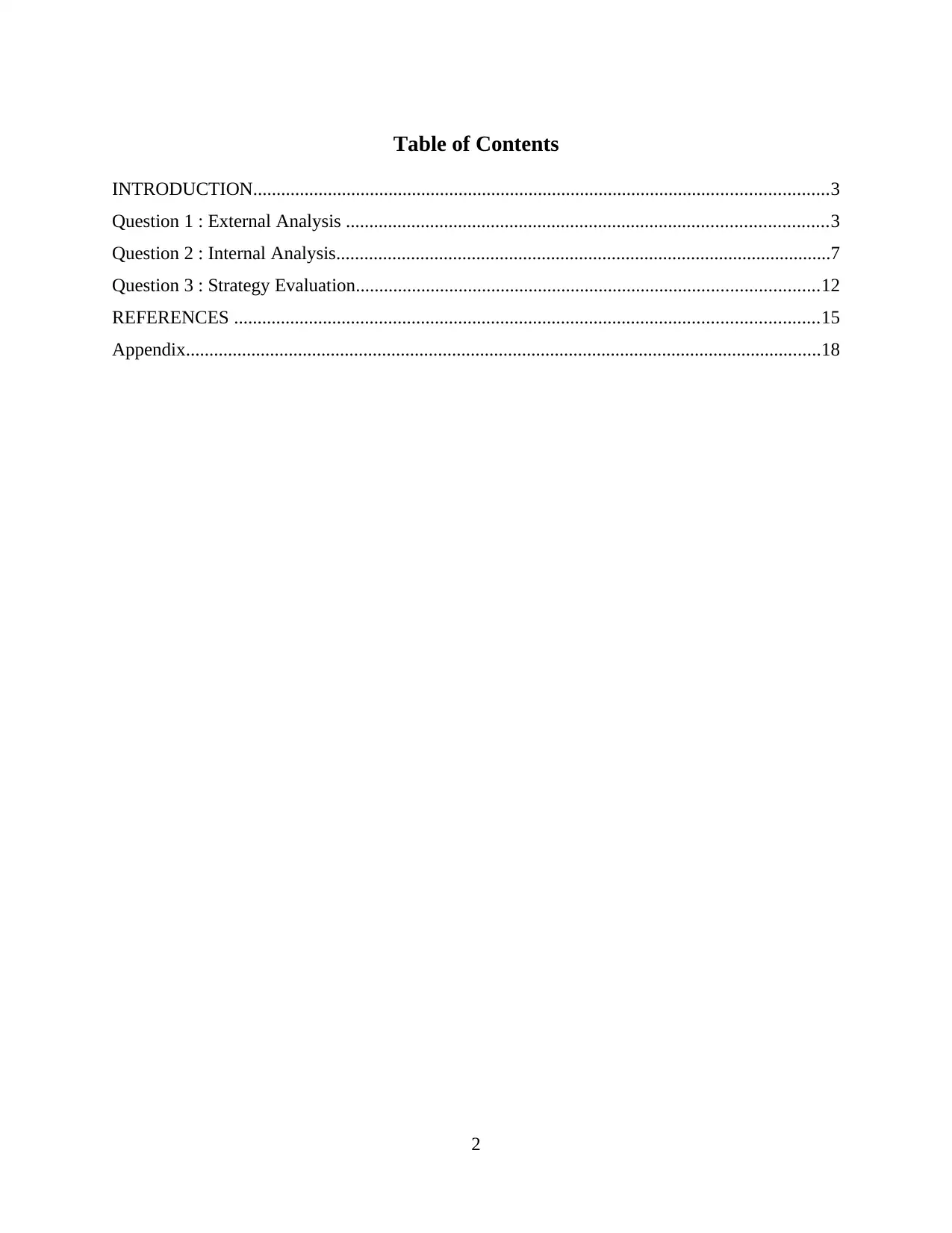
Table of Contents
INTRODUCTION...........................................................................................................................3
Question 1 : External Analysis .......................................................................................................3
Question 2 : Internal Analysis..........................................................................................................7
Question 3 : Strategy Evaluation...................................................................................................12
REFERENCES .............................................................................................................................15
Appendix........................................................................................................................................18
2
INTRODUCTION...........................................................................................................................3
Question 1 : External Analysis .......................................................................................................3
Question 2 : Internal Analysis..........................................................................................................7
Question 3 : Strategy Evaluation...................................................................................................12
REFERENCES .............................................................................................................................15
Appendix........................................................................................................................................18
2
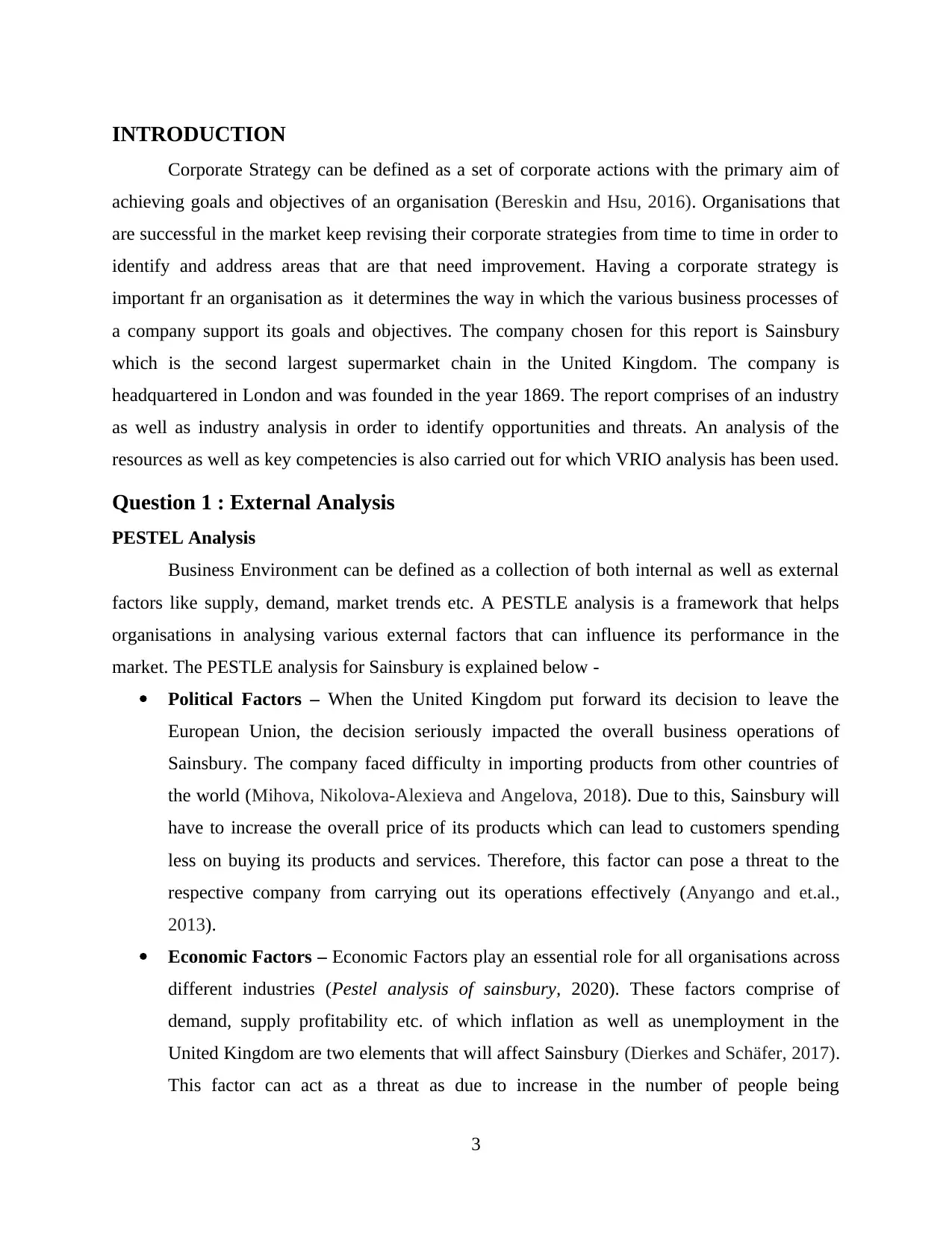
INTRODUCTION
Corporate Strategy can be defined as a set of corporate actions with the primary aim of
achieving goals and objectives of an organisation (Bereskin and Hsu, 2016). Organisations that
are successful in the market keep revising their corporate strategies from time to time in order to
identify and address areas that are that need improvement. Having a corporate strategy is
important fr an organisation as it determines the way in which the various business processes of
a company support its goals and objectives. The company chosen for this report is Sainsbury
which is the second largest supermarket chain in the United Kingdom. The company is
headquartered in London and was founded in the year 1869. The report comprises of an industry
as well as industry analysis in order to identify opportunities and threats. An analysis of the
resources as well as key competencies is also carried out for which VRIO analysis has been used.
Question 1 : External Analysis
PESTEL Analysis
Business Environment can be defined as a collection of both internal as well as external
factors like supply, demand, market trends etc. A PESTLE analysis is a framework that helps
organisations in analysing various external factors that can influence its performance in the
market. The PESTLE analysis for Sainsbury is explained below -
Political Factors – When the United Kingdom put forward its decision to leave the
European Union, the decision seriously impacted the overall business operations of
Sainsbury. The company faced difficulty in importing products from other countries of
the world (Mihova, Nikolova-Alexieva and Angelova, 2018). Due to this, Sainsbury will
have to increase the overall price of its products which can lead to customers spending
less on buying its products and services. Therefore, this factor can pose a threat to the
respective company from carrying out its operations effectively (Anyango and et.al.,
2013).
Economic Factors – Economic Factors play an essential role for all organisations across
different industries (Pestel analysis of sainsbury, 2020). These factors comprise of
demand, supply profitability etc. of which inflation as well as unemployment in the
United Kingdom are two elements that will affect Sainsbury (Dierkes and Schäfer, 2017).
This factor can act as a threat as due to increase in the number of people being
3
Corporate Strategy can be defined as a set of corporate actions with the primary aim of
achieving goals and objectives of an organisation (Bereskin and Hsu, 2016). Organisations that
are successful in the market keep revising their corporate strategies from time to time in order to
identify and address areas that are that need improvement. Having a corporate strategy is
important fr an organisation as it determines the way in which the various business processes of
a company support its goals and objectives. The company chosen for this report is Sainsbury
which is the second largest supermarket chain in the United Kingdom. The company is
headquartered in London and was founded in the year 1869. The report comprises of an industry
as well as industry analysis in order to identify opportunities and threats. An analysis of the
resources as well as key competencies is also carried out for which VRIO analysis has been used.
Question 1 : External Analysis
PESTEL Analysis
Business Environment can be defined as a collection of both internal as well as external
factors like supply, demand, market trends etc. A PESTLE analysis is a framework that helps
organisations in analysing various external factors that can influence its performance in the
market. The PESTLE analysis for Sainsbury is explained below -
Political Factors – When the United Kingdom put forward its decision to leave the
European Union, the decision seriously impacted the overall business operations of
Sainsbury. The company faced difficulty in importing products from other countries of
the world (Mihova, Nikolova-Alexieva and Angelova, 2018). Due to this, Sainsbury will
have to increase the overall price of its products which can lead to customers spending
less on buying its products and services. Therefore, this factor can pose a threat to the
respective company from carrying out its operations effectively (Anyango and et.al.,
2013).
Economic Factors – Economic Factors play an essential role for all organisations across
different industries (Pestel analysis of sainsbury, 2020). These factors comprise of
demand, supply profitability etc. of which inflation as well as unemployment in the
United Kingdom are two elements that will affect Sainsbury (Dierkes and Schäfer, 2017).
This factor can act as a threat as due to increase in the number of people being
3
⊘ This is a preview!⊘
Do you want full access?
Subscribe today to unlock all pages.

Trusted by 1+ million students worldwide
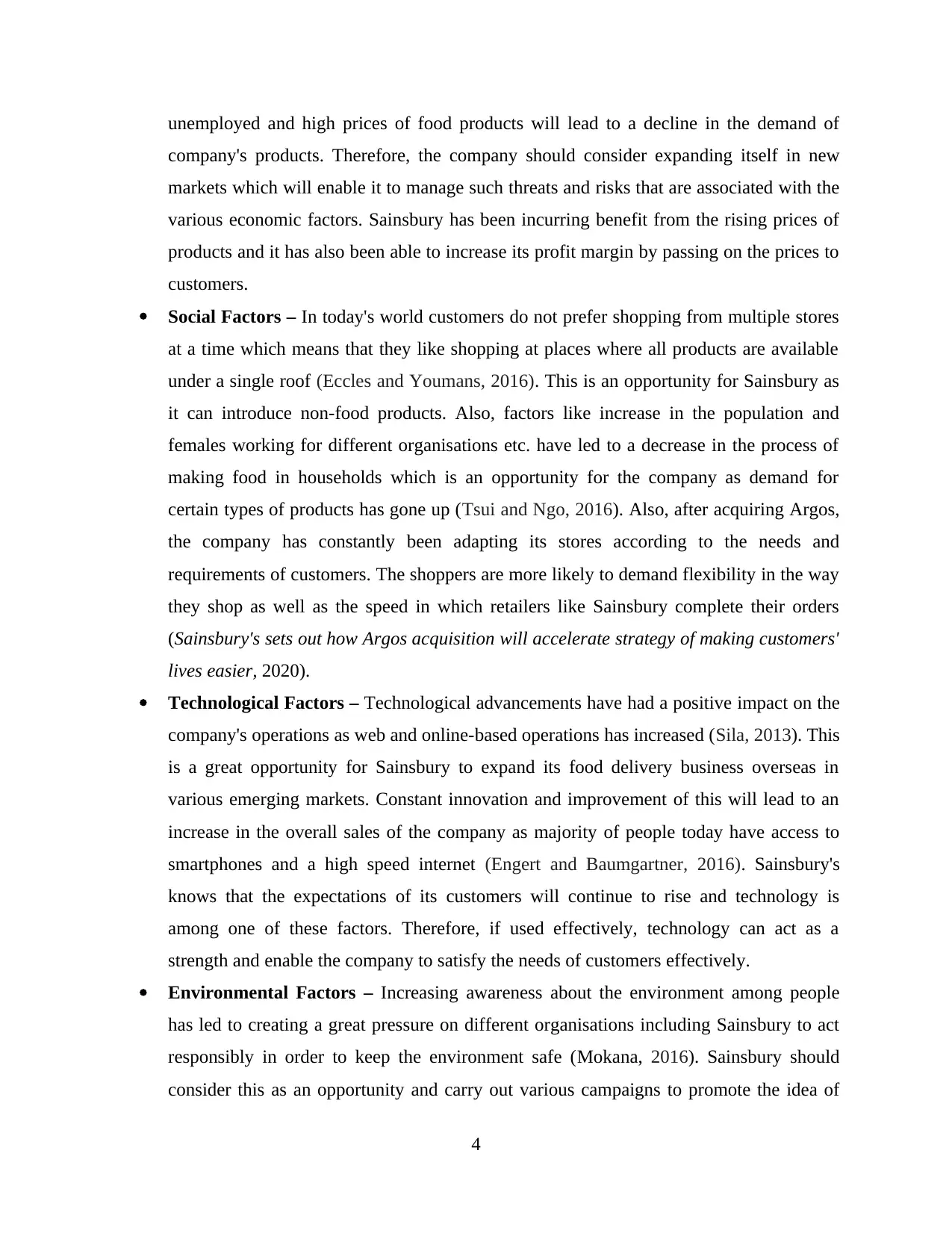
unemployed and high prices of food products will lead to a decline in the demand of
company's products. Therefore, the company should consider expanding itself in new
markets which will enable it to manage such threats and risks that are associated with the
various economic factors. Sainsbury has been incurring benefit from the rising prices of
products and it has also been able to increase its profit margin by passing on the prices to
customers.
Social Factors – In today's world customers do not prefer shopping from multiple stores
at a time which means that they like shopping at places where all products are available
under a single roof (Eccles and Youmans, 2016). This is an opportunity for Sainsbury as
it can introduce non-food products. Also, factors like increase in the population and
females working for different organisations etc. have led to a decrease in the process of
making food in households which is an opportunity for the company as demand for
certain types of products has gone up (Tsui and Ngo, 2016). Also, after acquiring Argos,
the company has constantly been adapting its stores according to the needs and
requirements of customers. The shoppers are more likely to demand flexibility in the way
they shop as well as the speed in which retailers like Sainsbury complete their orders
(Sainsbury's sets out how Argos acquisition will accelerate strategy of making customers'
lives easier, 2020).
Technological Factors – Technological advancements have had a positive impact on the
company's operations as web and online-based operations has increased (Sila, 2013). This
is a great opportunity for Sainsbury to expand its food delivery business overseas in
various emerging markets. Constant innovation and improvement of this will lead to an
increase in the overall sales of the company as majority of people today have access to
smartphones and a high speed internet (Engert and Baumgartner, 2016). Sainsbury's
knows that the expectations of its customers will continue to rise and technology is
among one of these factors. Therefore, if used effectively, technology can act as a
strength and enable the company to satisfy the needs of customers effectively.
Environmental Factors – Increasing awareness about the environment among people
has led to creating a great pressure on different organisations including Sainsbury to act
responsibly in order to keep the environment safe (Mokana, 2016). Sainsbury should
consider this as an opportunity and carry out various campaigns to promote the idea of
4
company's products. Therefore, the company should consider expanding itself in new
markets which will enable it to manage such threats and risks that are associated with the
various economic factors. Sainsbury has been incurring benefit from the rising prices of
products and it has also been able to increase its profit margin by passing on the prices to
customers.
Social Factors – In today's world customers do not prefer shopping from multiple stores
at a time which means that they like shopping at places where all products are available
under a single roof (Eccles and Youmans, 2016). This is an opportunity for Sainsbury as
it can introduce non-food products. Also, factors like increase in the population and
females working for different organisations etc. have led to a decrease in the process of
making food in households which is an opportunity for the company as demand for
certain types of products has gone up (Tsui and Ngo, 2016). Also, after acquiring Argos,
the company has constantly been adapting its stores according to the needs and
requirements of customers. The shoppers are more likely to demand flexibility in the way
they shop as well as the speed in which retailers like Sainsbury complete their orders
(Sainsbury's sets out how Argos acquisition will accelerate strategy of making customers'
lives easier, 2020).
Technological Factors – Technological advancements have had a positive impact on the
company's operations as web and online-based operations has increased (Sila, 2013). This
is a great opportunity for Sainsbury to expand its food delivery business overseas in
various emerging markets. Constant innovation and improvement of this will lead to an
increase in the overall sales of the company as majority of people today have access to
smartphones and a high speed internet (Engert and Baumgartner, 2016). Sainsbury's
knows that the expectations of its customers will continue to rise and technology is
among one of these factors. Therefore, if used effectively, technology can act as a
strength and enable the company to satisfy the needs of customers effectively.
Environmental Factors – Increasing awareness about the environment among people
has led to creating a great pressure on different organisations including Sainsbury to act
responsibly in order to keep the environment safe (Mokana, 2016). Sainsbury should
consider this as an opportunity and carry out various campaigns to promote the idea of
4
Paraphrase This Document
Need a fresh take? Get an instant paraphrase of this document with our AI Paraphraser
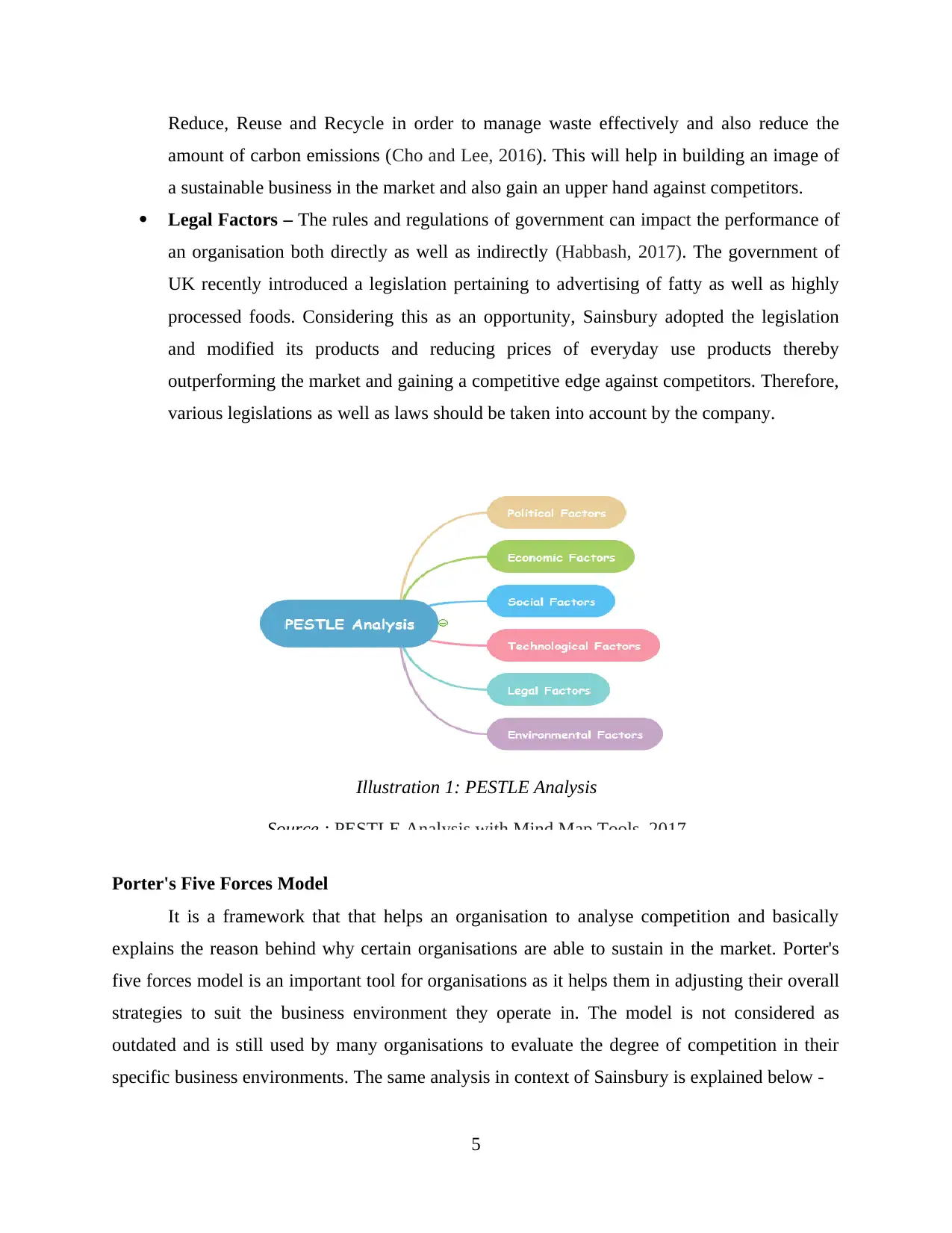
Reduce, Reuse and Recycle in order to manage waste effectively and also reduce the
amount of carbon emissions (Cho and Lee, 2016). This will help in building an image of
a sustainable business in the market and also gain an upper hand against competitors.
Legal Factors – The rules and regulations of government can impact the performance of
an organisation both directly as well as indirectly (Habbash, 2017). The government of
UK recently introduced a legislation pertaining to advertising of fatty as well as highly
processed foods. Considering this as an opportunity, Sainsbury adopted the legislation
and modified its products and reducing prices of everyday use products thereby
outperforming the market and gaining a competitive edge against competitors. Therefore,
various legislations as well as laws should be taken into account by the company.
Porter's Five Forces Model
It is a framework that that helps an organisation to analyse competition and basically
explains the reason behind why certain organisations are able to sustain in the market. Porter's
five forces model is an important tool for organisations as it helps them in adjusting their overall
strategies to suit the business environment they operate in. The model is not considered as
outdated and is still used by many organisations to evaluate the degree of competition in their
specific business environments. The same analysis in context of Sainsbury is explained below -
5
Illustration 1: PESTLE Analysis
Source : PESTLE Analysis with Mind Map Tools, 2017
amount of carbon emissions (Cho and Lee, 2016). This will help in building an image of
a sustainable business in the market and also gain an upper hand against competitors.
Legal Factors – The rules and regulations of government can impact the performance of
an organisation both directly as well as indirectly (Habbash, 2017). The government of
UK recently introduced a legislation pertaining to advertising of fatty as well as highly
processed foods. Considering this as an opportunity, Sainsbury adopted the legislation
and modified its products and reducing prices of everyday use products thereby
outperforming the market and gaining a competitive edge against competitors. Therefore,
various legislations as well as laws should be taken into account by the company.
Porter's Five Forces Model
It is a framework that that helps an organisation to analyse competition and basically
explains the reason behind why certain organisations are able to sustain in the market. Porter's
five forces model is an important tool for organisations as it helps them in adjusting their overall
strategies to suit the business environment they operate in. The model is not considered as
outdated and is still used by many organisations to evaluate the degree of competition in their
specific business environments. The same analysis in context of Sainsbury is explained below -
5
Illustration 1: PESTLE Analysis
Source : PESTLE Analysis with Mind Map Tools, 2017
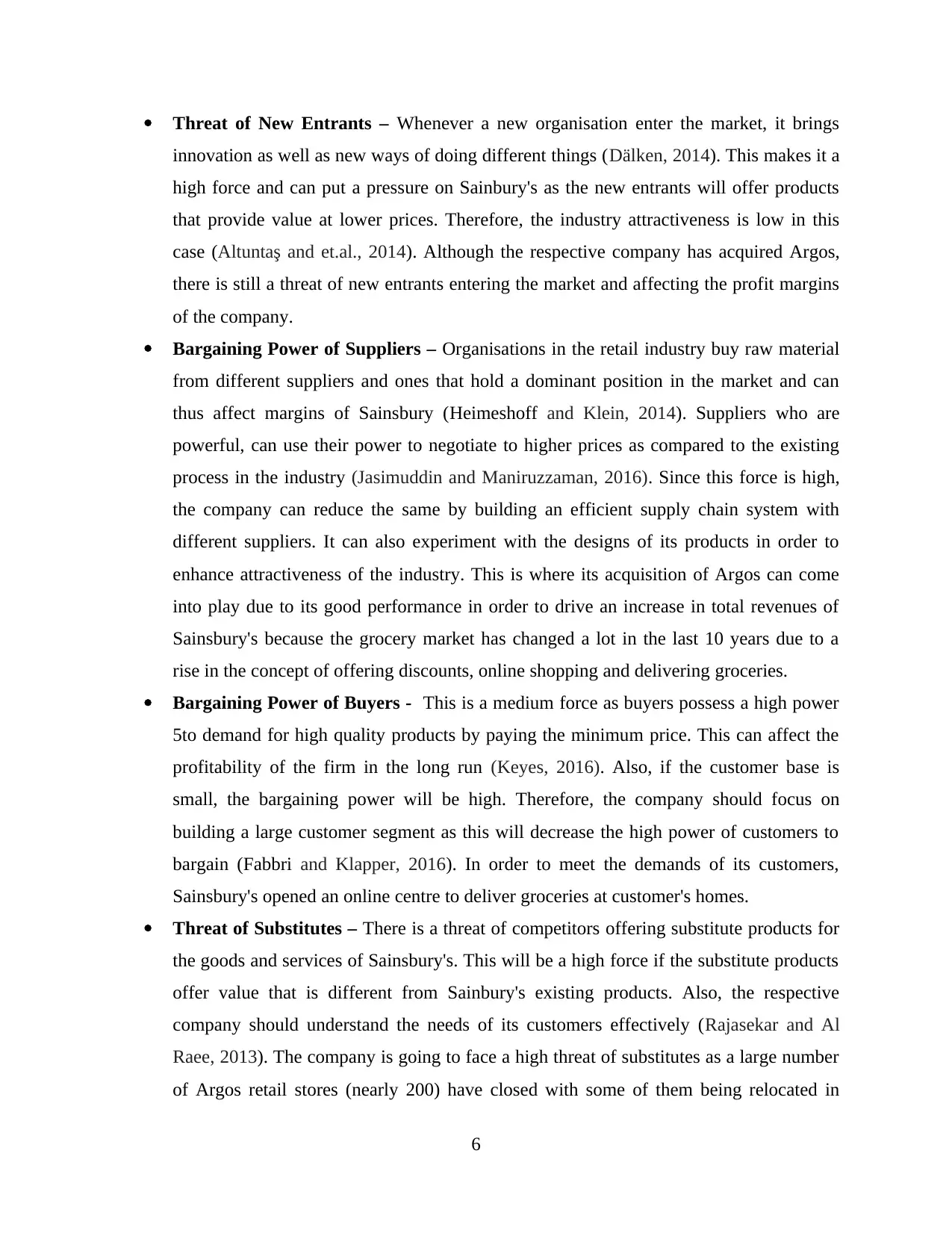
Threat of New Entrants – Whenever a new organisation enter the market, it brings
innovation as well as new ways of doing different things (Dälken, 2014). This makes it a
high force and can put a pressure on Sainbury's as the new entrants will offer products
that provide value at lower prices. Therefore, the industry attractiveness is low in this
case (Altuntaş and et.al., 2014). Although the respective company has acquired Argos,
there is still a threat of new entrants entering the market and affecting the profit margins
of the company.
Bargaining Power of Suppliers – Organisations in the retail industry buy raw material
from different suppliers and ones that hold a dominant position in the market and can
thus affect margins of Sainsbury (Heimeshoff and Klein, 2014). Suppliers who are
powerful, can use their power to negotiate to higher prices as compared to the existing
process in the industry (Jasimuddin and Maniruzzaman, 2016). Since this force is high,
the company can reduce the same by building an efficient supply chain system with
different suppliers. It can also experiment with the designs of its products in order to
enhance attractiveness of the industry. This is where its acquisition of Argos can come
into play due to its good performance in order to drive an increase in total revenues of
Sainsbury's because the grocery market has changed a lot in the last 10 years due to a
rise in the concept of offering discounts, online shopping and delivering groceries.
Bargaining Power of Buyers - This is a medium force as buyers possess a high power
5to demand for high quality products by paying the minimum price. This can affect the
profitability of the firm in the long run (Keyes, 2016). Also, if the customer base is
small, the bargaining power will be high. Therefore, the company should focus on
building a large customer segment as this will decrease the high power of customers to
bargain (Fabbri and Klapper, 2016). In order to meet the demands of its customers,
Sainsbury's opened an online centre to deliver groceries at customer's homes.
Threat of Substitutes – There is a threat of competitors offering substitute products for
the goods and services of Sainsbury's. This will be a high force if the substitute products
offer value that is different from Sainbury's existing products. Also, the respective
company should understand the needs of its customers effectively (Rajasekar and Al
Raee, 2013). The company is going to face a high threat of substitutes as a large number
of Argos retail stores (nearly 200) have closed with some of them being relocated in
6
innovation as well as new ways of doing different things (Dälken, 2014). This makes it a
high force and can put a pressure on Sainbury's as the new entrants will offer products
that provide value at lower prices. Therefore, the industry attractiveness is low in this
case (Altuntaş and et.al., 2014). Although the respective company has acquired Argos,
there is still a threat of new entrants entering the market and affecting the profit margins
of the company.
Bargaining Power of Suppliers – Organisations in the retail industry buy raw material
from different suppliers and ones that hold a dominant position in the market and can
thus affect margins of Sainsbury (Heimeshoff and Klein, 2014). Suppliers who are
powerful, can use their power to negotiate to higher prices as compared to the existing
process in the industry (Jasimuddin and Maniruzzaman, 2016). Since this force is high,
the company can reduce the same by building an efficient supply chain system with
different suppliers. It can also experiment with the designs of its products in order to
enhance attractiveness of the industry. This is where its acquisition of Argos can come
into play due to its good performance in order to drive an increase in total revenues of
Sainsbury's because the grocery market has changed a lot in the last 10 years due to a
rise in the concept of offering discounts, online shopping and delivering groceries.
Bargaining Power of Buyers - This is a medium force as buyers possess a high power
5to demand for high quality products by paying the minimum price. This can affect the
profitability of the firm in the long run (Keyes, 2016). Also, if the customer base is
small, the bargaining power will be high. Therefore, the company should focus on
building a large customer segment as this will decrease the high power of customers to
bargain (Fabbri and Klapper, 2016). In order to meet the demands of its customers,
Sainsbury's opened an online centre to deliver groceries at customer's homes.
Threat of Substitutes – There is a threat of competitors offering substitute products for
the goods and services of Sainsbury's. This will be a high force if the substitute products
offer value that is different from Sainbury's existing products. Also, the respective
company should understand the needs of its customers effectively (Rajasekar and Al
Raee, 2013). The company is going to face a high threat of substitutes as a large number
of Argos retail stores (nearly 200) have closed with some of them being relocated in
6
⊘ This is a preview!⊘
Do you want full access?
Subscribe today to unlock all pages.

Trusted by 1+ million students worldwide
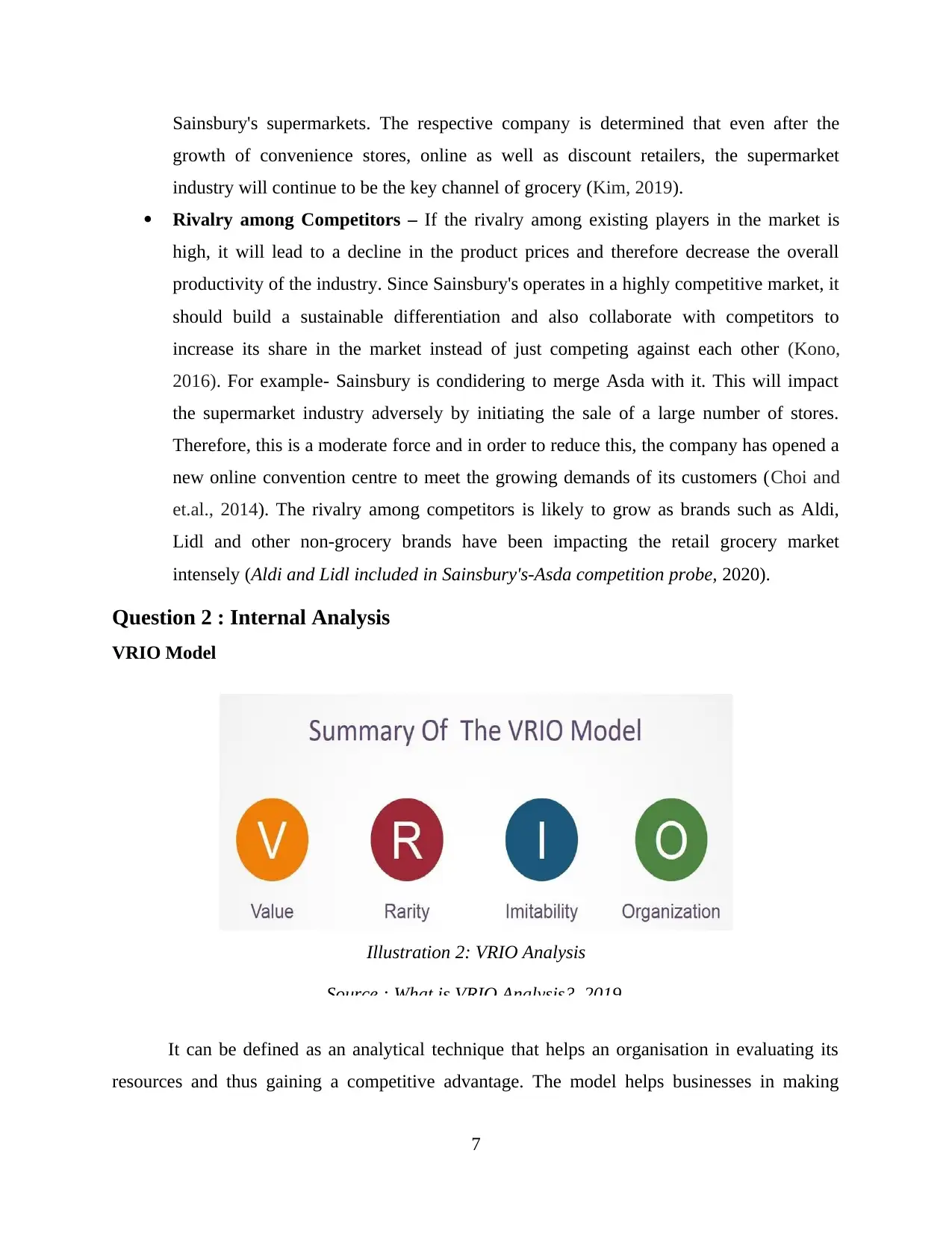
Sainsbury's supermarkets. The respective company is determined that even after the
growth of convenience stores, online as well as discount retailers, the supermarket
industry will continue to be the key channel of grocery (Kim, 2019).
Rivalry among Competitors – If the rivalry among existing players in the market is
high, it will lead to a decline in the product prices and therefore decrease the overall
productivity of the industry. Since Sainsbury's operates in a highly competitive market, it
should build a sustainable differentiation and also collaborate with competitors to
increase its share in the market instead of just competing against each other (Kono,
2016). For example- Sainsbury is condidering to merge Asda with it. This will impact
the supermarket industry adversely by initiating the sale of a large number of stores.
Therefore, this is a moderate force and in order to reduce this, the company has opened a
new online convention centre to meet the growing demands of its customers (Choi and
et.al., 2014). The rivalry among competitors is likely to grow as brands such as Aldi,
Lidl and other non-grocery brands have been impacting the retail grocery market
intensely (Aldi and Lidl included in Sainsbury's-Asda competition probe, 2020).
Question 2 : Internal Analysis
VRIO Model
It can be defined as an analytical technique that helps an organisation in evaluating its
resources and thus gaining a competitive advantage. The model helps businesses in making
7
Illustration 2: VRIO Analysis
Source : What is VRIO Analysis?. 2019.
growth of convenience stores, online as well as discount retailers, the supermarket
industry will continue to be the key channel of grocery (Kim, 2019).
Rivalry among Competitors – If the rivalry among existing players in the market is
high, it will lead to a decline in the product prices and therefore decrease the overall
productivity of the industry. Since Sainsbury's operates in a highly competitive market, it
should build a sustainable differentiation and also collaborate with competitors to
increase its share in the market instead of just competing against each other (Kono,
2016). For example- Sainsbury is condidering to merge Asda with it. This will impact
the supermarket industry adversely by initiating the sale of a large number of stores.
Therefore, this is a moderate force and in order to reduce this, the company has opened a
new online convention centre to meet the growing demands of its customers (Choi and
et.al., 2014). The rivalry among competitors is likely to grow as brands such as Aldi,
Lidl and other non-grocery brands have been impacting the retail grocery market
intensely (Aldi and Lidl included in Sainsbury's-Asda competition probe, 2020).
Question 2 : Internal Analysis
VRIO Model
It can be defined as an analytical technique that helps an organisation in evaluating its
resources and thus gaining a competitive advantage. The model helps businesses in making
7
Illustration 2: VRIO Analysis
Source : What is VRIO Analysis?. 2019.
Paraphrase This Document
Need a fresh take? Get an instant paraphrase of this document with our AI Paraphraser
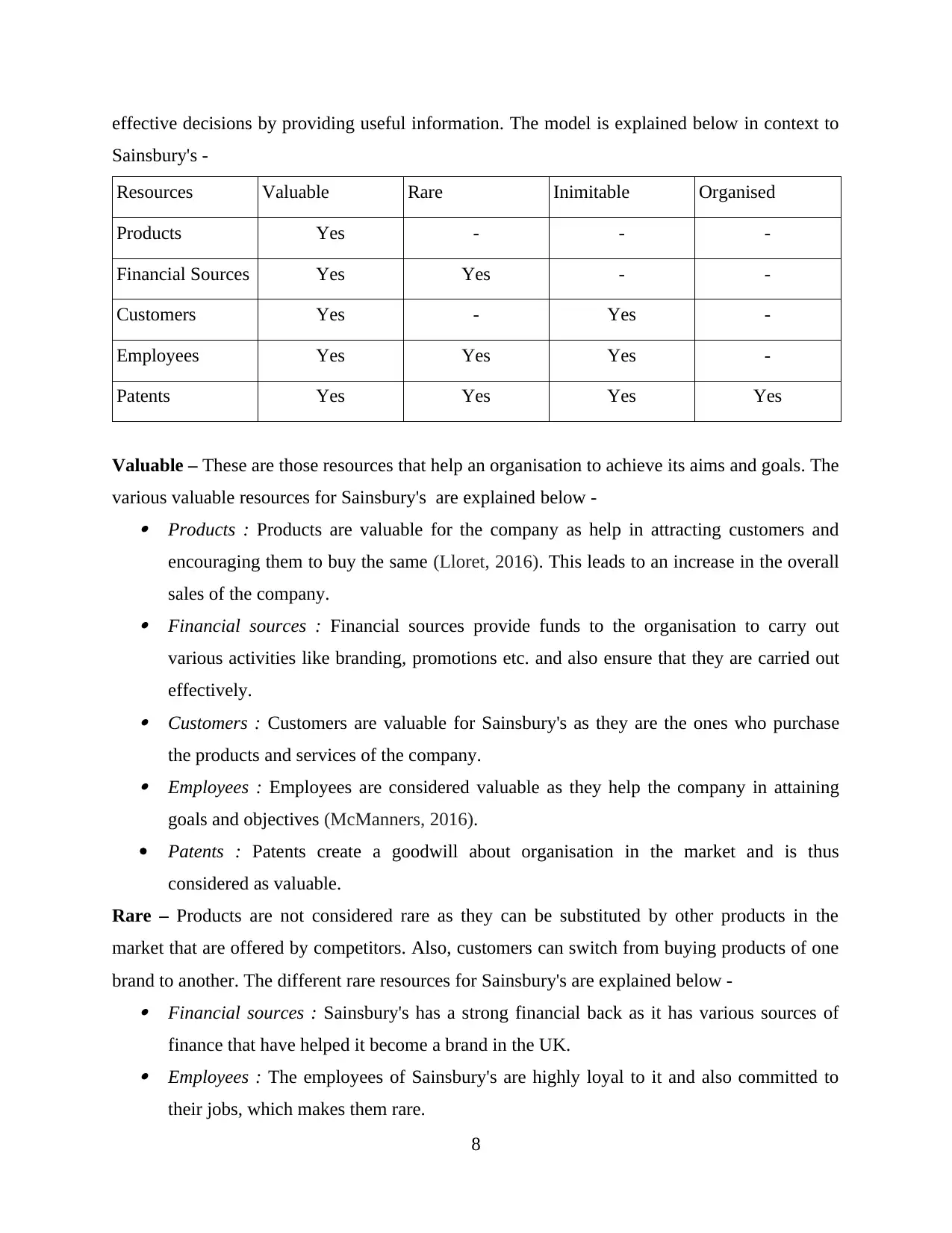
effective decisions by providing useful information. The model is explained below in context to
Sainsbury's -
Resources Valuable Rare Inimitable Organised
Products Yes - - -
Financial Sources Yes Yes - -
Customers Yes - Yes -
Employees Yes Yes Yes -
Patents Yes Yes Yes Yes
Valuable – These are those resources that help an organisation to achieve its aims and goals. The
various valuable resources for Sainsbury's are explained below - Products : Products are valuable for the company as help in attracting customers and
encouraging them to buy the same (Lloret, 2016). This leads to an increase in the overall
sales of the company. Financial sources : Financial sources provide funds to the organisation to carry out
various activities like branding, promotions etc. and also ensure that they are carried out
effectively. Customers : Customers are valuable for Sainsbury's as they are the ones who purchase
the products and services of the company. Employees : Employees are considered valuable as they help the company in attaining
goals and objectives (McManners, 2016).
Patents : Patents create a goodwill about organisation in the market and is thus
considered as valuable.
Rare – Products are not considered rare as they can be substituted by other products in the
market that are offered by competitors. Also, customers can switch from buying products of one
brand to another. The different rare resources for Sainsbury's are explained below - Financial sources : Sainsbury's has a strong financial back as it has various sources of
finance that have helped it become a brand in the UK. Employees : The employees of Sainsbury's are highly loyal to it and also committed to
their jobs, which makes them rare.
8
Sainsbury's -
Resources Valuable Rare Inimitable Organised
Products Yes - - -
Financial Sources Yes Yes - -
Customers Yes - Yes -
Employees Yes Yes Yes -
Patents Yes Yes Yes Yes
Valuable – These are those resources that help an organisation to achieve its aims and goals. The
various valuable resources for Sainsbury's are explained below - Products : Products are valuable for the company as help in attracting customers and
encouraging them to buy the same (Lloret, 2016). This leads to an increase in the overall
sales of the company. Financial sources : Financial sources provide funds to the organisation to carry out
various activities like branding, promotions etc. and also ensure that they are carried out
effectively. Customers : Customers are valuable for Sainsbury's as they are the ones who purchase
the products and services of the company. Employees : Employees are considered valuable as they help the company in attaining
goals and objectives (McManners, 2016).
Patents : Patents create a goodwill about organisation in the market and is thus
considered as valuable.
Rare – Products are not considered rare as they can be substituted by other products in the
market that are offered by competitors. Also, customers can switch from buying products of one
brand to another. The different rare resources for Sainsbury's are explained below - Financial sources : Sainsbury's has a strong financial back as it has various sources of
finance that have helped it become a brand in the UK. Employees : The employees of Sainsbury's are highly loyal to it and also committed to
their jobs, which makes them rare.
8
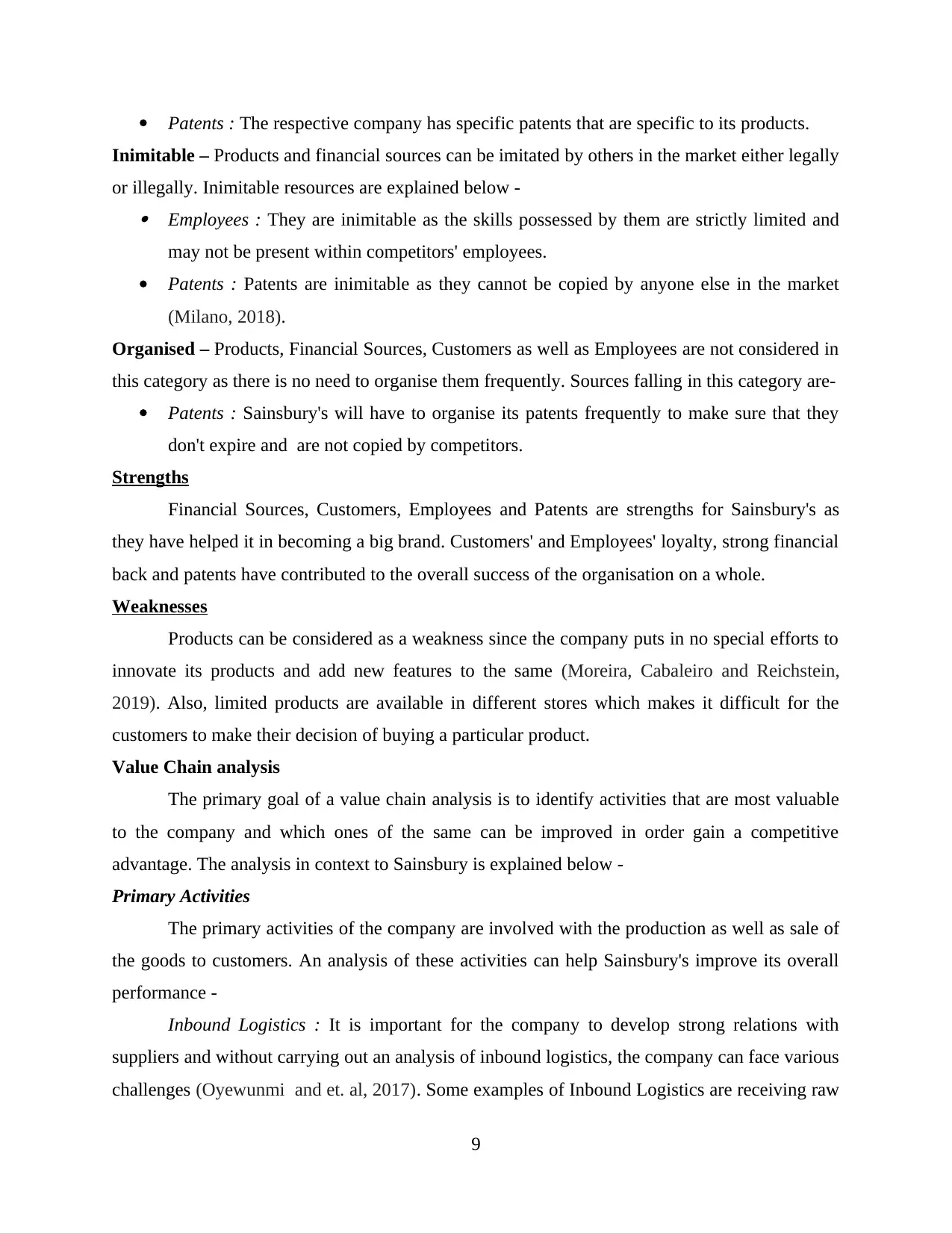
Patents : The respective company has specific patents that are specific to its products.
Inimitable – Products and financial sources can be imitated by others in the market either legally
or illegally. Inimitable resources are explained below - Employees : They are inimitable as the skills possessed by them are strictly limited and
may not be present within competitors' employees.
Patents : Patents are inimitable as they cannot be copied by anyone else in the market
(Milano, 2018).
Organised – Products, Financial Sources, Customers as well as Employees are not considered in
this category as there is no need to organise them frequently. Sources falling in this category are-
Patents : Sainsbury's will have to organise its patents frequently to make sure that they
don't expire and are not copied by competitors.
Strengths
Financial Sources, Customers, Employees and Patents are strengths for Sainsbury's as
they have helped it in becoming a big brand. Customers' and Employees' loyalty, strong financial
back and patents have contributed to the overall success of the organisation on a whole.
Weaknesses
Products can be considered as a weakness since the company puts in no special efforts to
innovate its products and add new features to the same (Moreira, Cabaleiro and Reichstein,
2019). Also, limited products are available in different stores which makes it difficult for the
customers to make their decision of buying a particular product.
Value Chain analysis
The primary goal of a value chain analysis is to identify activities that are most valuable
to the company and which ones of the same can be improved in order gain a competitive
advantage. The analysis in context to Sainsbury is explained below -
Primary Activities
The primary activities of the company are involved with the production as well as sale of
the goods to customers. An analysis of these activities can help Sainsbury's improve its overall
performance -
Inbound Logistics : It is important for the company to develop strong relations with
suppliers and without carrying out an analysis of inbound logistics, the company can face various
challenges (Oyewunmi and et. al, 2017). Some examples of Inbound Logistics are receiving raw
9
Inimitable – Products and financial sources can be imitated by others in the market either legally
or illegally. Inimitable resources are explained below - Employees : They are inimitable as the skills possessed by them are strictly limited and
may not be present within competitors' employees.
Patents : Patents are inimitable as they cannot be copied by anyone else in the market
(Milano, 2018).
Organised – Products, Financial Sources, Customers as well as Employees are not considered in
this category as there is no need to organise them frequently. Sources falling in this category are-
Patents : Sainsbury's will have to organise its patents frequently to make sure that they
don't expire and are not copied by competitors.
Strengths
Financial Sources, Customers, Employees and Patents are strengths for Sainsbury's as
they have helped it in becoming a big brand. Customers' and Employees' loyalty, strong financial
back and patents have contributed to the overall success of the organisation on a whole.
Weaknesses
Products can be considered as a weakness since the company puts in no special efforts to
innovate its products and add new features to the same (Moreira, Cabaleiro and Reichstein,
2019). Also, limited products are available in different stores which makes it difficult for the
customers to make their decision of buying a particular product.
Value Chain analysis
The primary goal of a value chain analysis is to identify activities that are most valuable
to the company and which ones of the same can be improved in order gain a competitive
advantage. The analysis in context to Sainsbury is explained below -
Primary Activities
The primary activities of the company are involved with the production as well as sale of
the goods to customers. An analysis of these activities can help Sainsbury's improve its overall
performance -
Inbound Logistics : It is important for the company to develop strong relations with
suppliers and without carrying out an analysis of inbound logistics, the company can face various
challenges (Oyewunmi and et. al, 2017). Some examples of Inbound Logistics are receiving raw
9
⊘ This is a preview!⊘
Do you want full access?
Subscribe today to unlock all pages.

Trusted by 1+ million students worldwide
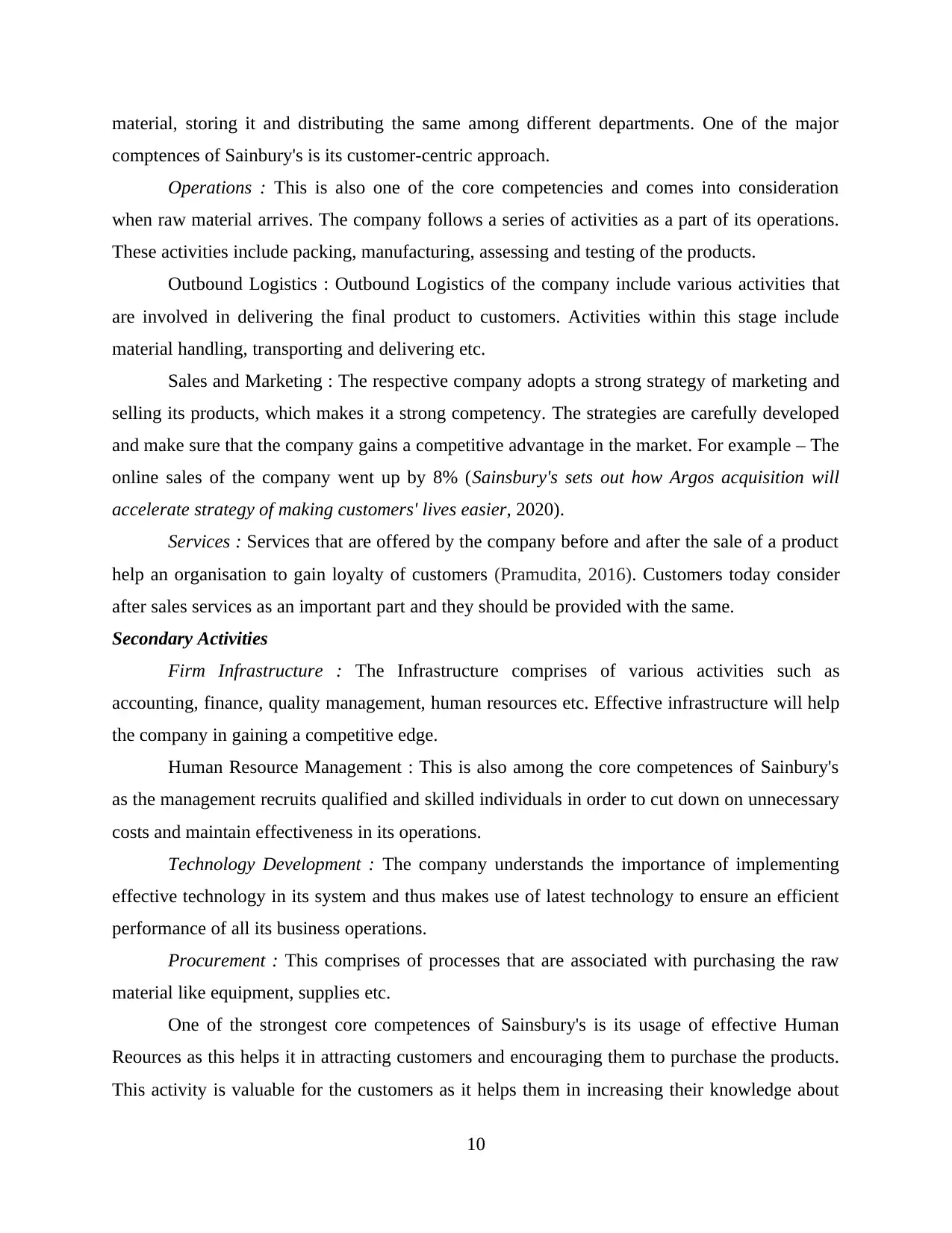
material, storing it and distributing the same among different departments. One of the major
comptences of Sainbury's is its customer-centric approach.
Operations : This is also one of the core competencies and comes into consideration
when raw material arrives. The company follows a series of activities as a part of its operations.
These activities include packing, manufacturing, assessing and testing of the products.
Outbound Logistics : Outbound Logistics of the company include various activities that
are involved in delivering the final product to customers. Activities within this stage include
material handling, transporting and delivering etc.
Sales and Marketing : The respective company adopts a strong strategy of marketing and
selling its products, which makes it a strong competency. The strategies are carefully developed
and make sure that the company gains a competitive advantage in the market. For example – The
online sales of the company went up by 8% (Sainsbury's sets out how Argos acquisition will
accelerate strategy of making customers' lives easier, 2020).
Services : Services that are offered by the company before and after the sale of a product
help an organisation to gain loyalty of customers (Pramudita, 2016). Customers today consider
after sales services as an important part and they should be provided with the same.
Secondary Activities
Firm Infrastructure : The Infrastructure comprises of various activities such as
accounting, finance, quality management, human resources etc. Effective infrastructure will help
the company in gaining a competitive edge.
Human Resource Management : This is also among the core competences of Sainbury's
as the management recruits qualified and skilled individuals in order to cut down on unnecessary
costs and maintain effectiveness in its operations.
Technology Development : The company understands the importance of implementing
effective technology in its system and thus makes use of latest technology to ensure an efficient
performance of all its business operations.
Procurement : This comprises of processes that are associated with purchasing the raw
material like equipment, supplies etc.
One of the strongest core competences of Sainsbury's is its usage of effective Human
Reources as this helps it in attracting customers and encouraging them to purchase the products.
This activity is valuable for the customers as it helps them in increasing their knowledge about
10
comptences of Sainbury's is its customer-centric approach.
Operations : This is also one of the core competencies and comes into consideration
when raw material arrives. The company follows a series of activities as a part of its operations.
These activities include packing, manufacturing, assessing and testing of the products.
Outbound Logistics : Outbound Logistics of the company include various activities that
are involved in delivering the final product to customers. Activities within this stage include
material handling, transporting and delivering etc.
Sales and Marketing : The respective company adopts a strong strategy of marketing and
selling its products, which makes it a strong competency. The strategies are carefully developed
and make sure that the company gains a competitive advantage in the market. For example – The
online sales of the company went up by 8% (Sainsbury's sets out how Argos acquisition will
accelerate strategy of making customers' lives easier, 2020).
Services : Services that are offered by the company before and after the sale of a product
help an organisation to gain loyalty of customers (Pramudita, 2016). Customers today consider
after sales services as an important part and they should be provided with the same.
Secondary Activities
Firm Infrastructure : The Infrastructure comprises of various activities such as
accounting, finance, quality management, human resources etc. Effective infrastructure will help
the company in gaining a competitive edge.
Human Resource Management : This is also among the core competences of Sainbury's
as the management recruits qualified and skilled individuals in order to cut down on unnecessary
costs and maintain effectiveness in its operations.
Technology Development : The company understands the importance of implementing
effective technology in its system and thus makes use of latest technology to ensure an efficient
performance of all its business operations.
Procurement : This comprises of processes that are associated with purchasing the raw
material like equipment, supplies etc.
One of the strongest core competences of Sainsbury's is its usage of effective Human
Reources as this helps it in attracting customers and encouraging them to purchase the products.
This activity is valuable for the customers as it helps them in increasing their knowledge about
10
Paraphrase This Document
Need a fresh take? Get an instant paraphrase of this document with our AI Paraphraser
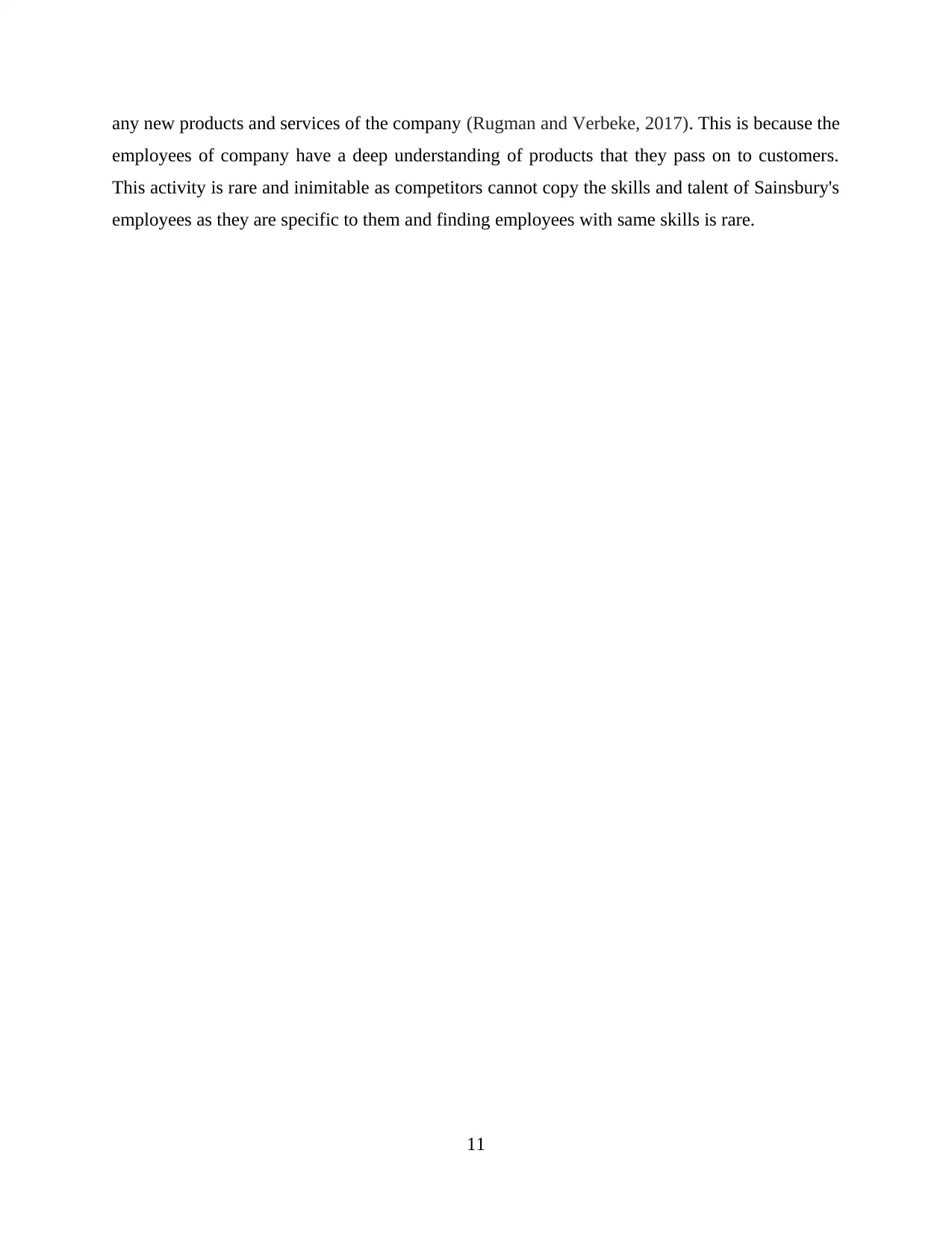
any new products and services of the company (Rugman and Verbeke, 2017). This is because the
employees of company have a deep understanding of products that they pass on to customers.
This activity is rare and inimitable as competitors cannot copy the skills and talent of Sainsbury's
employees as they are specific to them and finding employees with same skills is rare.
11
employees of company have a deep understanding of products that they pass on to customers.
This activity is rare and inimitable as competitors cannot copy the skills and talent of Sainsbury's
employees as they are specific to them and finding employees with same skills is rare.
11
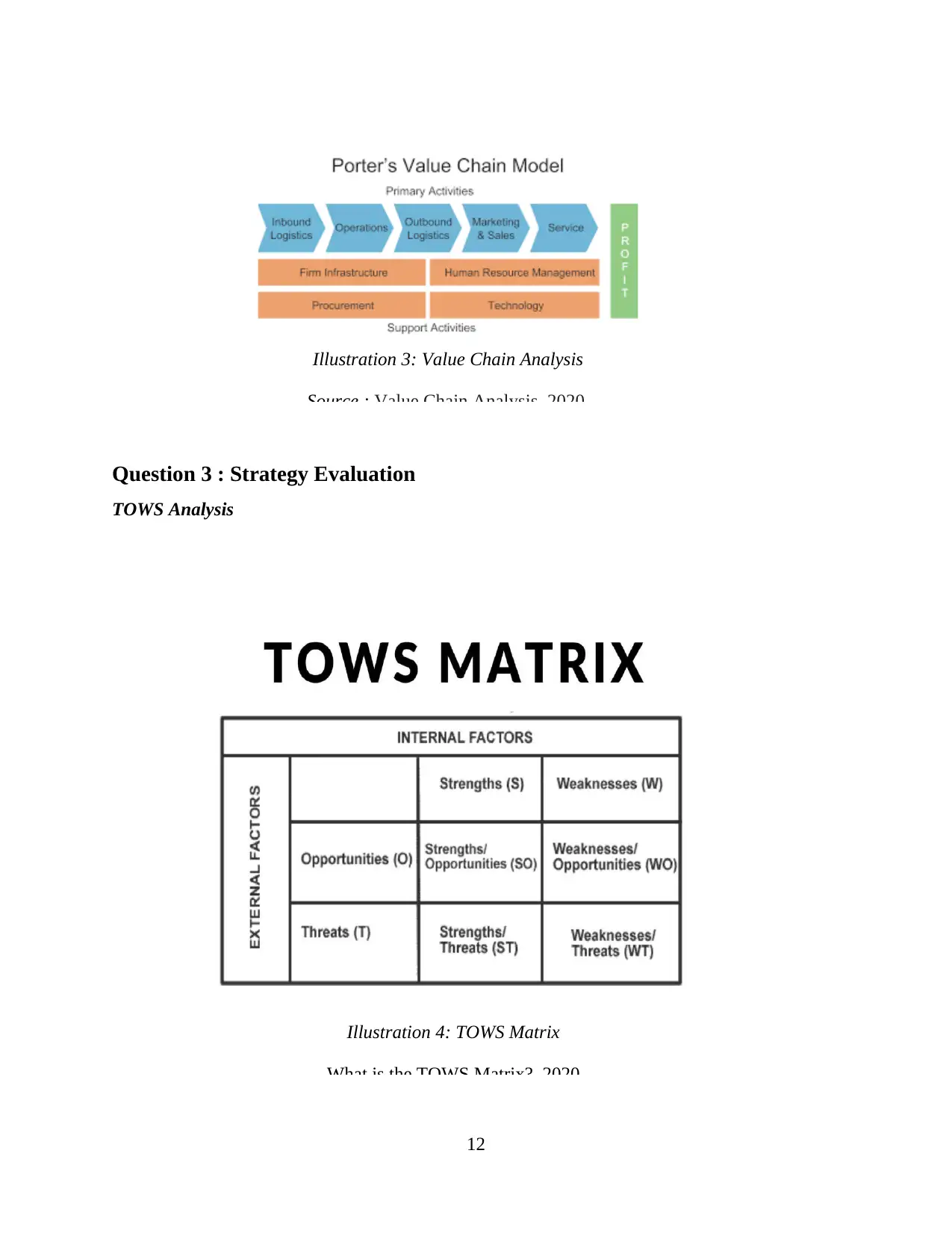
Question 3 : Strategy Evaluation
TOWS Analysis
12
Illustration 4: TOWS Matrix
What is the TOWS Matrix?, 2020
Illustration 3: Value Chain Analysis
Source : Value Chain Analysis. 2020.
TOWS Analysis
12
Illustration 4: TOWS Matrix
What is the TOWS Matrix?, 2020
Illustration 3: Value Chain Analysis
Source : Value Chain Analysis. 2020.
⊘ This is a preview!⊘
Do you want full access?
Subscribe today to unlock all pages.

Trusted by 1+ million students worldwide
1 out of 19
Related Documents
Your All-in-One AI-Powered Toolkit for Academic Success.
+13062052269
info@desklib.com
Available 24*7 on WhatsApp / Email
![[object Object]](/_next/static/media/star-bottom.7253800d.svg)
Unlock your academic potential
Copyright © 2020–2025 A2Z Services. All Rights Reserved. Developed and managed by ZUCOL.




